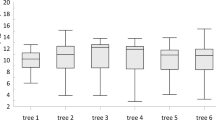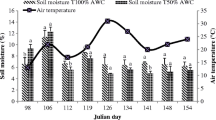Summary
The response of elements of the water balance of olive plants grown in desert farms to partial irrigation was investigated. Among these are transpiration, leaf relative water content, the number of leaves carried by trees and the osmotic pressure of the leaf sap. The proper time for irrigation and suitable ways of its application were also studied. A method of applying subsurface irrigation, to minimize direct evaporation from the soil, is described. The results show a slight decrease in transpiration rate of irrigated plants compared to the controls. However, an increase in the number of leaves as a result of irrigation was found to result in increased total transpirational water loss. An inverse relation seem to exist between the amount of foliage and its relative water content in periods of no active growth. This relation is reversed during active growth. The osmotic pressure of leaf sap also responded inversely to changes in leaf water content during periods of inactive growth. On time of active growth, relative water content and osmotic pressure rose more or less together. The results indicate that among the methods of irrigation studied, summer subsurface irrigation is more favourable for the water balance of the plant.
Similar content being viewed by others
References
Abd El-Rahman A. A., and El-Hadidi M. N., Observations on the water output of the desert vegetation along Cairo-Suez Road. U.A.R. J. Botany, 1, 19–38 (1958).
Abd El-Rahman A. A., and Batanouny K. H., Transpiration of desert plants in Wadi-Hoff. U.A.R. J. Botany, 7, 37–59 (1963).
Abd El-Rahman A. A., Batanouny K. H., Osmotic pressure of desert plants under different environmental conditions. U.A.R. J. Botany, 7, 95–107 (1964).
Abd El-Rahman A. A., and Batanouny K. H., and Ezzat N. H., Water economy of barley under desert conditions. Flora, 156 252–274 (1966).
Abd El-Rahman A. A., Shalaby A. F., and Balegh M. S., Water economy of olive under desert conditions. Flora 156, 202–219 (1966).
Abd El-Rahman A. A., Shalaby A. F., and Balegh M. S., Water relations of almond under desert conditions. Bull. Fac. Sci. Cairo Univ. 40, 13–28 (1966).
Abd El-Rahman A. A., and El-Monayeri M. O., Contributions to the auto-ecology of Ononis vaginalis. Phyton (Austria) 12, 228–251 (1967).
Abd El-Rahman, A. A., and El-Sharkawi, H. M., Response of olive and almond orchards to partial irrigation under dryfarming practices in semi-arid regions. I-Evaporation from the soil. Bull. Fac. Sci. Cairo Univ. 45 (In press) (1972).
Anderson N. E., Hertz C. H., and Rufelt H., A new fast recording hygrometer for plant transpiration measurements. Physiol. Plantarum 7, 733–767 (1954).
Eckardt, F. E., Ecophysiological measurement techniques applied to research on water relations of plants in arid- and semi-arid regions. Arid Zone Research (UNESCO) 15, on plant water relations in arid and semi-arid conditions, reviews of research (1960).
Evenari, M., The water balance in plants in desert conditions. Proc. Desert Research Inst. Intern. Symp. Jerusalem (1953).
Halevy A., Orange leaf transpiration under orchard conditions. A contribution to the methodology of transpiration measurements in Citrus leaves. Israel Research Couucil Bull. Sect. D (Bot.) 5, 155–164 (1956).
Huber B., Zur methodik der Transpiration bestimmung am Standort. Ber. Deutsch. Botan Ges. 45, 611–618 (1927).
Konis E., The effect of leaf temperature on transpiration. Ecology 31: 147–148 (1950).
Kramer P. J. and Kozlowski T. T., Physiology of Trees. McCraw Hill Book Co., New York, 1960
Kreeb K. Hydratur und Ertrag. Ber. Deutsch Botan Ges. 70, 121–136 (1957).
Kreeb, K., Hydrature and plant production. In Water Relations of Plants. British Ecol. Soc. Symp. 3, 272–288 (1963).
Migahid A. M. Abd El-RahmanA. A., Studies on the water economy of Egyptian desert plants. III- Observations on the drought resistance of desert plants. Bull. Inst. Des. d'Egypte 3, 58–83 (1953).
Migahid A. M. and El-Shafei M., Osmotic pressure of plant sap as related to salinity and water content of the soil. Bull. Inst. Des. d'Egypte 5, 57–81 (1955).
Migahid A. M., The drought resistance of Egyptian desert plants. Arid Zone Research (UNESCO). Proc. Madrid Symp. on plant-water relationships in arid and semi-arid conditions 15, 213–233 (1962).
Rufelt H., Influence of root pressure on the transpiration of wheat plants. Physiol. Plantarum 9, 154–164 (1956).
Slatyer, R. O. and McIlroy, I. C., Practical Climatiology, C.S.I.R.O. & UNESCO (1961).
Stocker O., Eine Feldmethode zur Bestimmung der momentanen Transpiration-und Evapotranspirationgrösse, I Ber. Deut. Botany Ges. 47, 126–129 (1929).
Stocker O., Eine Feldmethode zur Bestimmung der momentanen Transpiration-und Evapotranspirationgrösse, II. Ber. Deut. Botan. Ges. 47, 130–136, (1929).
Stocker, O., Messmethoden der Transpiration. In W. Ruhland (ed.), Encyclopedia of Plant Physiology 3, 436–488 (1956).
Stocker, O., Die Abhängigkeit der Transpiration von den Unweltfaktoren. In W. Ruhland (ed.), Encyclopedia of Plant Physiology 3, 436–488 (1956).
Tadros T. M., Osmotic pressure of Egyptian desert plants in relation to their water supply. Bull. Fac. Sci. Cairo Univ. 7, 1–35 (1936).
Walter H., Die Hydratur der Pflanze undihre physiologisch-olilogische Bedeutung. (Untersuchungen uber den osmotischen Wart.). Jena, G. Fisher, 174 pp. (1931).
Walter, H., Die kryoscopische Bestimmung des osmotischen Wertes bei Pflanzen. In: E. Abderhalden (ed.). Handbuch der Biologischen Arbeitmethoden, Band II, 4, 353–371 (1931).
Walter H., Grundlagen der Pflanzen verbreitung. Einführung in die Pflanzengeographie für Studierende der Hochschulen, Standortslehre. Stuttgart, Ulmer (1949).
Weatherly P. E., Studies on the water relations of cotton plants. I. The field measurement of the water deficit in leaves. New Phytol. 49, 91–97 (1950).
Weatherly P. E. and BarrsC., A re-examination of the relative turgidity technique for estimating water deficit in leaves. Australian J. Biol. Sci. 15, 413–428 (1962).
Zohary, M., On hydro-ecological relations of the Near East desert vegetation. Proc. Arid Zone Research Symp. on Plant Water Relations in Arid and Semi-arid Conditions, UNESCO, Madrid. pp. 199–212 (1961).
Zohary M., Plant Life of Palestine. The Ronald Press Co., Inc., New York (1962).
Additional information
Botany Departments, Faculty of Science, Cario and Assiut Universities, Egypt
Rights and permissions
About this article
Cite this article
Abdel-Rahman, A.A., El-Sharkawi, H.M. Response of olive and almond orchards to partial irrigation under dry-farming practices in semi-arid regions:. Plant Soil 41, 13–31 (1974). https://doi.org/10.1007/BF00017940
Received:
Issue Date:
DOI: https://doi.org/10.1007/BF00017940




